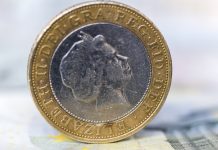Brexit uncertainty saw the pound drop 0.7% versus the dollar on Thursday. The pound US dollar exchange rate dived to a low of US$1.3068.
| What do these figures mean? |
|---|
| When measuring the value of a pair of currencies, one set equals 1 unit and the other shows the current equivalent. As the market moves, the amount will vary from minute to minute.For example, it could be written:1 GBP = 1.28934 USD Here, £1 is equivalent to approximately $1.29. This specifically measures the pound’s worth against the dollar. If the US dollar amount increases in this pairing, it’s positive for the pound. Or, if you were looking at it the other way around:1 USD = 0.77786 GBP In this example, $1 is equivalent to approximately £0.78. This measures the US dollar’s worth versus the British pound. If the sterling number gets larger, it’s good news for the dollar. |
With the meaningful Brexit vote in Parliament just days away, pound traders are finding it difficult to focus on anything else. The pound came under pressure in the previous session as evidenced mounted that UK Prime Minister Theresa May has not been able break the impasse with Brussels over the Irish backstop arrangement. Officials from the EU and the UK have said that they are pessimistic that a deal will be agreed.
Hard-line Brexiteers in Parliament, who had been softening their stance over recent weeks, appear to be hardening their resolve again. With just a few days until the meaningful vote on 12th March, it is looking highly unlikely that the UK will be leaving the EU with a deal on 29th March. The increased level of uncertainty over what exit in the Brexit process has weighed on the pound,
| Why is a “soft” Brexit better for sterling than a “hard” Brexit? |
|---|
| A soft Brexit implies anything less than UK’s complete withdrawal from the EU. For example, it could mean the UK retains some form of membership to the European Union single market in exchange for some free movement of people, i.e. immigration. This is considered more positive than a “hard” Brexit, which is a full severance from the EU. The reason “soft” is considered more pound-friendly is because the economic impact would be lower. If there is less negative impact on the economy, foreign investors will continue to invest in the UK. As investment requires local currency, this increased demand for the pound then boosts its value. |
Today there is no UK economic data to distract investors. Brexit will remain the central focus for pound traders.
NFP In Focus
The mood for the dollar lifted in the previous session. This was largely thanks to the sharp sell off in the euro. The dollar trades inversely to the euro so when the euro devalues the dollar moves higher.
The euro sold off after the European Central Bank (ECB) downgraded growth and inflation for the region. Furthermore, ECB President Draghi said that interest rates won’t rise until 2020. This is a move back from summer 2019 date that the ECB had been indicating.
Dollar traders will focus on the US jobs report today. The US non-farm payroll is the most closely watch US economic indicator each month. Analysts are expecting that 180,000 jobs to have been created in February. This is down from the 304,000 created in January. Analysts are also expecting unemployment to tick lower to 3.9% and average wages to increase 0.3%, up from 0.1%.
Market participants are concerned that the US economy is slowing, and that jobs growth will slow. Should the data be weaker than forecast, the dollar could fall.
| How does the non-farm payroll (NFP) affect the US dollar? |
|---|
| It works like this, when there is low unemployment and high job creation, the demand for workers increases. As demand for workers goes up, wages for those workers also go up. Which means the workers are now taking home more money to spend on cars, houses or in the shops. As a result, demand for goods and services also increase, pushing the prices of the good and services higher. That’s also known as inflation. When inflation moves higher, central banks are more likely to raise interest rates, which then pushes up the currency’s worth. |
This publication is provided for general information purposes only and is not intended to cover every aspect of the topics with which it deals. It is not intended to amount to advice on which you should rely. You must obtain professional or specialist advice before taking, or refraining from, any action on the basis of the content in this publication. The information in this publication does not constitute legal, tax or other professional advice from TransferWise Inc., Currency Live or its affiliates. Prior results do not guarantee a similar outcome. We make no representations, warranties or guarantees, whether express or implied, that the content in the publication is accurate, complete or up to date. Consult our risk warning page for more details.
This article was initially published on TransferWise.com from the same author. The content at Currency Live is the sole opinion of the authors and in no way reflects the views of TransferWise Inc.





